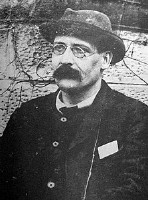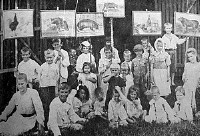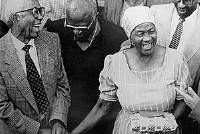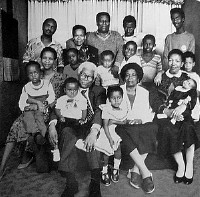This summer I've had the opportunity of learning about two seemingly contrary stories of collective aspiration. The Australian colony in Paraguay was a botched socialist project espousing equality of men, except for those who weren't white. On the other had, the freedom struggle in South Africa was an inspiring struggle for equality of men, which resulted in a workable nation state that provides a place for all colours.
 The leader William Lane combined his desire for worker's justice with a strong moral commitment to 'straightness', which included teetotalism and racial purity. It was interesting to read that after the failure of the colony in Paraguay, Lane went on to become editor of the New Zealand Herald, where he became a critic of unionism and advocate of imperialism, speaking often of 'We British...' There seem to be many reasons for the failure of the utopian quality, but a large measure of blame seems to lie with Lane whose self-pity left him unable to respond to the problems of others.
The leader William Lane combined his desire for worker's justice with a strong moral commitment to 'straightness', which included teetotalism and racial purity. It was interesting to read that after the failure of the colony in Paraguay, Lane went on to become editor of the New Zealand Herald, where he became a critic of unionism and advocate of imperialism, speaking often of 'We British...' There seem to be many reasons for the failure of the utopian quality, but a large measure of blame seems to lie with Lane whose self-pity left him unable to respond to the problems of others.
Gavin Souter writes about the racism in New Australia:
'...the assumption that Anglo-Saxons were inherently superior to Hispano-Indians was as much a part of the colony's creed as teetotalism, a principle which had also been made explicit in the New Australia articles of association, but was now an unwritten law. The racial attitudes the colonists had brought with them from Australia were revealed by some of the facetious advertisements in Evening Notes: 'Boycott the Chinkie and save yourselves from the Yellow Agony by buying your vegetables from white gardener -- John Wilson'; 'Baxter's shoes - Nigger tickler clogs.'… this was not gracious, for on the whole Cosme fared well in its deadlings with the Government of Paraguay.'
Gavin Souter A Peculiar People: The Australians In Paraguay Sydney: Sydney University Press, 1968
By contrast, the lives of Walter and Albertina Sisulu demonstrated enormous courage and fortitude. The scenes at the Rivonia trial in 1963 were extraordinary, as men like Walter and Mandela were getting ready to spend an indefinite period in Robben Island, and their wives Albertina and Winnie virtual widowhood. At the time, it seemed like the apartheid regime so lacked legitimacy that it was bound to crumble. To think that it would take another thirty years to finally end.
A recent book by their daughter-in-law Elinor artlessly balances dramas on the main political stage with the small domestic scenes that hold life togther. Here's an interesting practice that developed late in the struggle:
'The Sisulu family observed a 'Black Christmas' at the end of 1985. This was the practice, began after the 1976 uprising, of eschewing the luxuries associated with Christmas and keeping expenditure to a bare minimum. Black South Africans felt that they had nothing to celebrate and saw no reason to swell the coffers of white-owned businesses. By 1985, there was almost a total observation of 'Black Christmas' in black communities around the country. Some white also observed this practice…'
Elinor Sisulu Walter & Albertina Sisulu: In Our Lifetime London: Abacus, 2003 (orig. 2002), p. 430
I realise that this kind of comparison is in danger of being judged an expression of self-loathing typical of liberal elite in Australia. Rather than settling into a fixed position about Australia as a 'white fortress', I prefer to see its history as a challenge for the future. Lane's experiment provides us today with the challenge of establishing a relationship with the Guaraní that he disregarded. It was interesting to meet with Ticio Escobar, the director of Paraguay's Museo del Barro (Museum of Mud), which houses work of the Hispanic-Guaraní Baroque. He had never heard of Nuevo Australia. Here perhaps is an opportunity to restore the conversation, and bring something of the Paraguayan culture to Australia.
The example of South Africa shows that 'our roots aren't our leaves'. The failures of the past point us to the potential successes of the future.



No comments:
Post a Comment